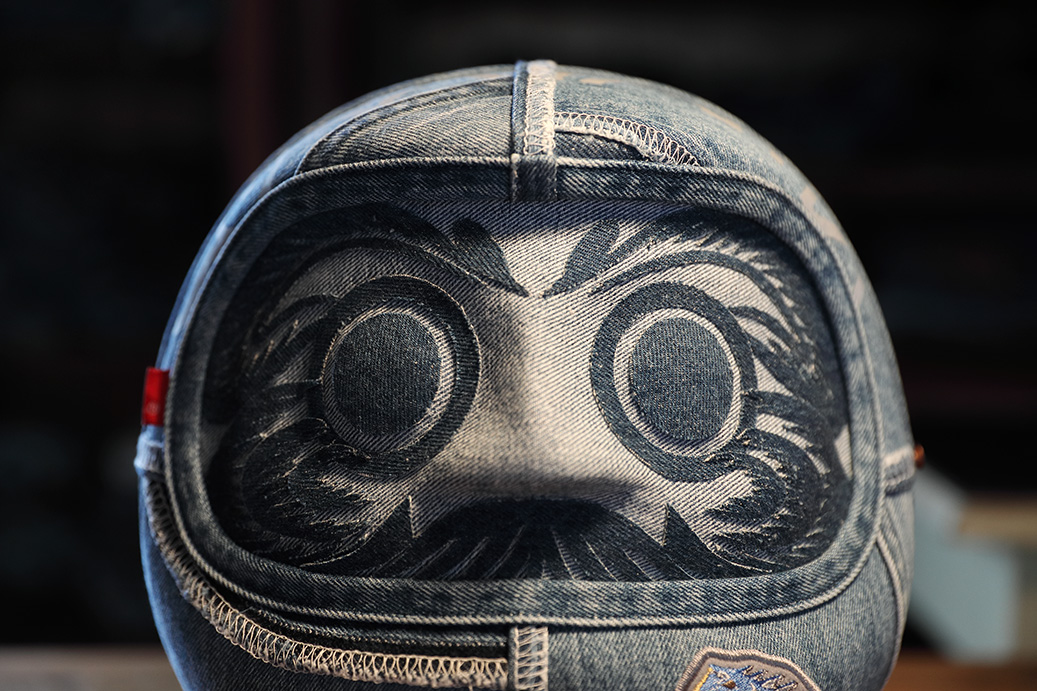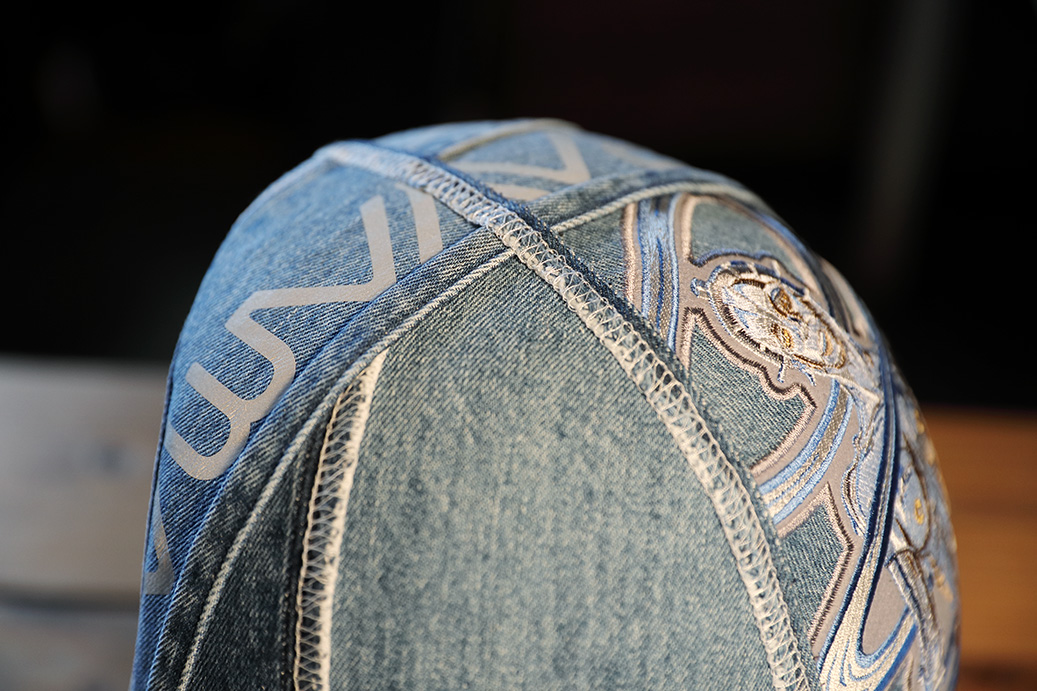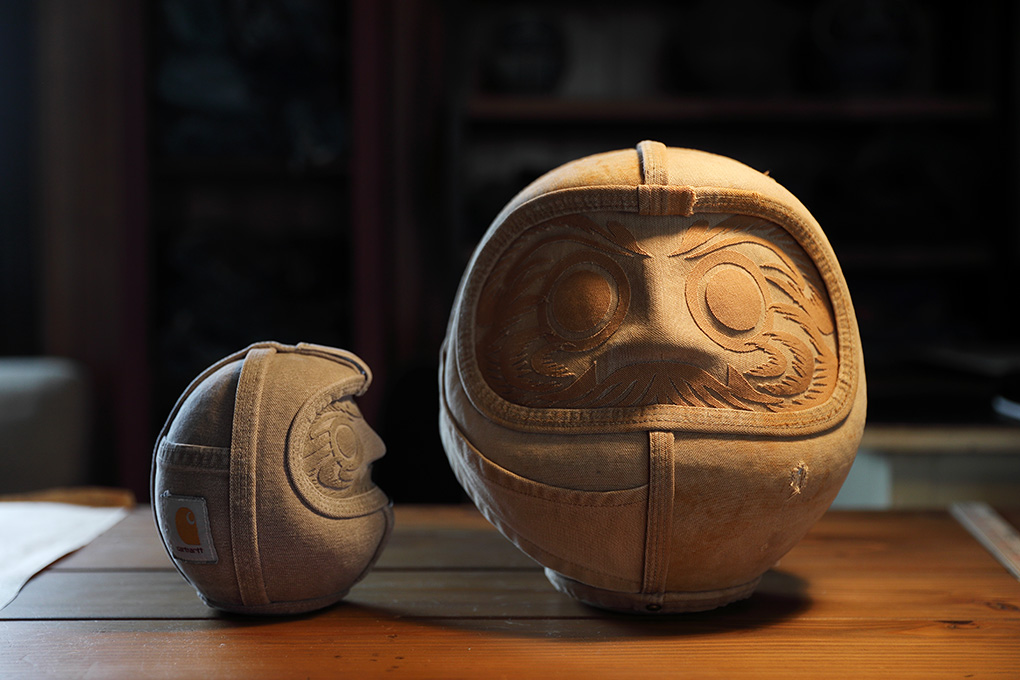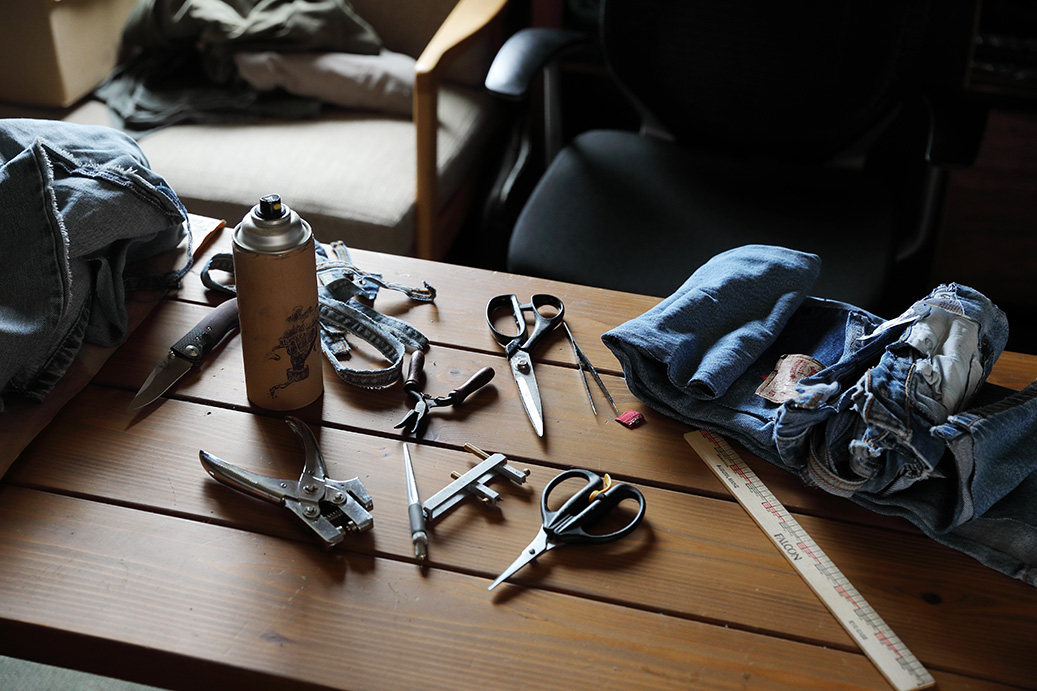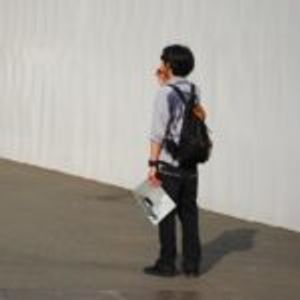The “daruma,” a round, traditional Japanese doll, has long been known as a symbol of perseverance and good luck. Today, the daruma is still widely used, often as a motif in picture books or a good luck charm for students taking exams. Former pro skateboarder Aoi Shimizu combines this Japanese tradition with iconic American denim to create one-of-a-kind pieces. His denim darumas, crafted from the fabric of discarded denim, have garnered considerable attention. Recently, he collaborated with Hajime Sorayama, an internationally-renowned artist who partnered with Dior last year. TOKION talks to this former professional skateboarder about the background behind his darumas.
Shimizu stopped skateboarding and became an artist
――I heard you were originally a pro skateboarder.
Aoi Shimizu (hereinafter Shimizu): I started skateboarding when I was 14 because I was fascinated by skate fashion and culture. Later, I was signed by a brand, and I became a pro skateboarder. In my pro skater years, I was spending all my time skateboarding and making videos with friends, while being sponsored by Nixon, Reebok, BackChannel, and Murasaki Sports. When I was 27, I was on the cover of “Transworld SKATEboarding Japan” magazine and also got married. I ended my pro skateboarding career around then.
――I see. So did you arrive at your current career as an artist soon after retiring from pro skateboarding?
Shimizu: No. My current style of art didn’t come to me so easily. I started graffiti in my skating days, so there were a lot of artists and art in my circle, and I really liked looking at art. Anyway, I wanted to try my hand at graffiti or illustration someday, but I was never really good at drawing. (laughs) So I figured that it wasn’t possible for me to draw or illustrate. But I had a really strong desire to create something. I started doing stencils and graffiti as a hobby, and just as I was thinking to myself that there were already a lot of people who were good at it, I noticed a pair of denim pants that had been worn out from skateboarding. From the way the color fades, to the way they’re ripped, torn, or frayed, or even stained with blood from a fall, I found it interesting how no two pairs of denim jeans are the same. I was thinking about how I could make the most out of jeans that would be thrown away anyway, and that’s how I arrived at denim crafts. From there, I was focused on finding a way to show the unique variation of jeans. Then, I searched for a way to weave in some traditional Japanese culture, and also made connections with new people, and that led me to daruma. A year later, I completed the prototype of the current daruma, and after another five years, it became what it is today.
――So you spent a lot of time developing your current creative style. What’s the process behind making denim daruma?
Shimizu: I use denim pants that are going to be discarded, and then it’s a process of simply cutting and pasting over and over. First, I break down the jeans into smaller parts, and then I picture it in my head and reconstruct it. I don’t have any set rules, so my darumas all come out with different patterns and colors. I think this variety is the beauty of the daruma.
――What are some of the challenges of creating darumas?
Shimizu: The hard part is their round shape. Since darumas aren’t flat, I have to figure out how to make them look beautiful and clean. I have to find ways to hide the gaps in the fabric to look like it was sewn. I also get rid of any extra fabric. Then, there’s the daruma’s expression. The daruma’s expression varies depending on the artist, and it also contains meaning. Because the daruma is a lucky charm, it’s filled with traditional elements like cranes, turtles, pine, bamboo, plum trees, and Mount Fuji, all of which are considered to be good luck. I made a daruma with an original expression based on the Soushu Daruma doll made in Hiratsuka City, close to my hometown, that has crane eyebrows, a turtle beard, and a Mount Fuji mouth.
――How long do they take to make?
Shimizu: At least a day. And I can only make one per pair of denim pants.
Denim darumas hold the spirit of Zen
――Where can people buy your daruma?
Shimizu: You can DM me on Instagram, or order from Concept Design Shonan Studio, where ACRAFT’s studio is, or clapp vintage, a shop in Fujisawa city, Kanagawa prefecture. When people place an order, I want to know why they’re ordering and where they plan to put the daruma, so I can express that idea through the placement of parts and colors. And if possible, I want to make their daruma using denim that’s meaningful to them. That way, it’ll be a one-of-a-kind daruma doll that’s made with your own memories. It’s customary to burn daruma after a wish is fulfilled, but since the denim daruma is made with the owner’s memories, my hope is that they’ll always be on display and never forgotten.
――What do you personally like about daruma?
Shimizu: I think it’s the spirit of Zen. If I went into detail about this, it’d be very long, so I’ll spare you the details–but it’s said that Bodhidharma, the founder of Zen Buddhism, took the form of the present day daruma after meditating for many years. The doll, which was based on this anecdote, was introduced to Japan from China in the Muromachi period (1336-1573), and then the current daruma design was created in the Edo period (1603-1868).
The spirit of Zen that Bodhidharma was in pursuit was “nothingness.” To be free of desire. To only be observing your own mind. Looking at a daruma is like looking at yourself in some way. It feels like the daruma is telling me that the answers to my own problems can be found within myself. I think that’s the charm of the daruma.
How skateboarding influences Shimizu’s art
――Do you draw on your skateboarding experience when you create darumas?
Shimizu: Of course. There are the connections I’ve made with people through skateboarding, and my stoic refusal to give up is still very much alive. When I used to learn how to do a new skateboarding trick, I would just keep repeating it over and over. Until I was able to pull something off easily, I would keep going at it until it felt like my body was going to give out. I believe that beyond my own limits lies meaning. That attitude lives on through my craft. When I make a daruma, once the work is finished, rather than being satisfied with it, I take it apart and rebuild it again. By repeating this process, I can create a piece that’s beyond what I originally imagined. In any case, it’s important not to give up.
――What’s your relationship to skateboarding now?
Shimizu: Even though I say I’ve stopped, my whole life used to revolve around skateboarding, so I still check out how people are skating, and I still ride, too. I guess skateboarding is just part of my life’s work.
――Has your work been affected by the coronavirus?
Shimizu: People have been worried for me, but it really hasn’t affected me at all. Actually, it was during the coronavirus pandemic that I started working on ACRAFT, making denim daruma. So in this coronavirus situation, I suddenly started receiving a lot of orders. Plus, I collaborated with Hajime Sorayama, so I’ve been quite busy non-stop. I guess if there’s any way in which I’ve been affected, I was supposed to have solo exhibitions in Taiwan and Hong Kong, but now I’m not able to go. But since the coronavirus, I’ve been able to spend more time with my family, and work on my denim daruma, so it’s not all that bad.
――Could you tell me about the solo exhibitions in Taiwan and Hong Kong?
Shimizu: In Taiwan, I was invited by Wrong Gallery, a gallery where Hajime Sorayama has done a solo exhibition before. I wanted to take the local culture and colors and incorporate them into the darumas. For the solo exhibition in Hong Kong, there’s a clothing shop called Hide & Seek that carries a lot of Japanese brands. I’ll be making daruma using vintage denim from Carhartt, which the shop owner says he holds dear.
――Do you have any goals for the future?
Shimizu: I started working with denim, but I’ve also used leather scraps from a factory before. So I’d like to get more involved in recycled art, using surplus materials to make a variety of things other than daruma. I call this kind of art “re-art.” To do that, I’d like to keep making these denim darumas to accumulate new techniques and ideas.
Aoi Shimizu
Aoi Shimizu is an artist born in 1986 in Samukawa, Kanagawa prefecture. After being featured in various media as a professional skater, he retired and became an artist. Using discarded denim pants, he started making his own denim daruma dolls. He has collaborated with the world-renowned artist Hajime Sorayama, and is currently working on upcoming solo exhibitions in Taiwan and Hong Kong.
Instagram:@a.craft86
Photography Shinpo Kimura
Translation Aya Apton



